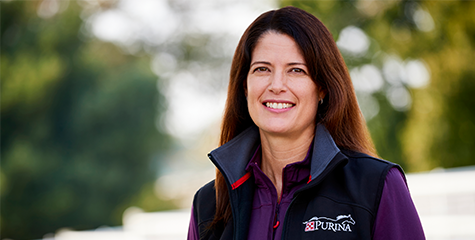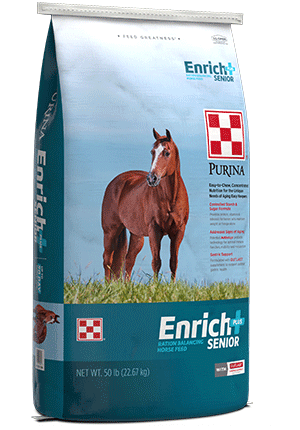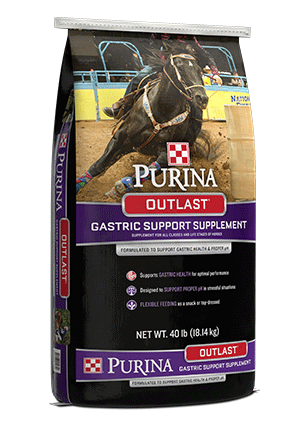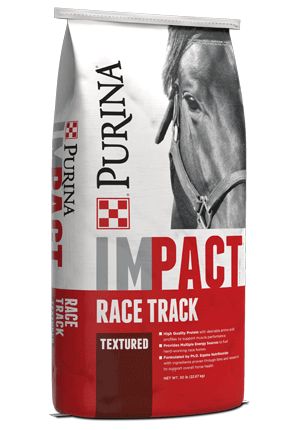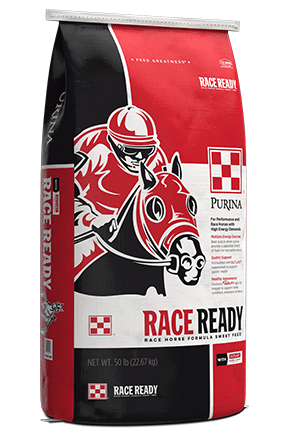
Feeding Horses for a Shiny Coat
Nutrition : General Nutrition
Everyone wants their horse to look so good that he/she turns heads.
Good breeding, correct conformation, and a strong topline are important, but the traditional hallmark of a beautiful horse is a shiny hair coat. Even horses without perfect conformation are eye-catching when they have a shiny coat.
Although we can’t do much about conformation flaws, we do have some level of control over the appearance of a horse’s coat. Good nutrition shows on the outside, and feeding a balanced diet that meets nutrient requirements is an essential first step to having a horse with a shiny coat. A deficiency in almost any nutrient has the potential to negatively affect the coat’s appearance. The most commonly observed deficiencies affecting skin and hair are protein (i.e. amino acids) and zinc. An amino acid deficiency can cause poor growth and dull appearance of the hair. Skin cells contain a moderate amount of zinc, and a zinc deficiency can lead to hair loss and even a condition called “parakeratosis”, which is characterized by severely thickened and cracked skin. Fortunately, insuring that a horse’s nutrient requirements are being met is as easy as following the feeding directions on any of Purina’s horse feed products.
The second step to a shiny coat is feeding extra fat. Although an essential fatty acid (EFA; omega-6 and omega-3 fatty acids) deficiency has never been documented in the horse (forages contain plenty of EFAs), horseman have recognized for years that supplementing fat to the horse’s diet has a positive effect on the hair coat. Hair itself is made up of protein, minerals and fatty acids, and feeding fat has been shown to alter the fatty acid composition of hair. Fatty acids are also a component of skin oils (sebum) that coat each strand of hair, giving the coat an oily protective barrier and a shiny appearance. Dietary fat facilitates the absorption of the fat soluble vitamins A, D, E and K which will also contribute to the appearance of a healthier hair coat.
The specific amount of dietary fat that will improve the appearance of the hair coat has not been precisely identified, but a good place to start is with an additional 30-60 grams of fat (1-2 oz oil) per day. The best results are seen when the supplemental fat contains a high proportion of omega-3 and omega-6 fatty acids from sources such as vegetable oils (i.e. corn, soybean), flaxseed, and rice bran. One option is Purina® Ahiflower® Oil, which is a highly-palatable, plant-based oil that provides benefits commonly associated with fish oil and is a more concentrated source of omega fatty acids than flaxseed oil. In addition to top-dressing supplemental oil, another way to supply extra fat is to feed a fat-added concentrate such as Purina® Strategy® Healthy Edge® horse feed or Purina® Ultium® Competition horse formula. Another option is to feed a fat supplement, and one of the most palatable extruded fat supplements you can buy is Purina® Amplify® high fat nugget. This fat supplement contains 30% total fat and is a patented, extruded nugget made from a blend of vegetable oil, flaxseed, and rice bran. It also contains added protein, vitamins, and minerals, making it an ideal supplement to feed for shine. To get results, feed at least ½ lb, and up to 4 lbs, per day. Purina® Amplify® high fat nugget is a great alternative to feeding large quantities of oil, because not only can oil be messy, but some horses won’t eat it readily. In addition, supplementing with straight flaxseed or rice bran may throw off the overall nutritional balance of the diet (they have an inverse Ca:P ratio). Purina® Omega Match® Ration Balancing Feed can also be used as a top-dress pelleted fat supplement at a rate of 1 - 2 lbs per day, and it is a good choice if a higher proportion of omega-3 fatty acids is desired. The horse has a fairly high tolerance for fat in the diet, but feeding fat in excess of 15% - 20% of the daily dry matter intake would potentially have a negative effect on fecal output and certain nutrient digestibilities.
Finally, the third step to achieving a shiny coat is good, old-fashioned elbow grease. There is nothing like a thorough grooming session to maximize the shine on a horse’s coat. But if you feed for a shine that comes from the inside out, there will definitely be less elbow grease required, leaving you with more time to stop and admire the gleaming coat on your horse.
Good breeding, correct conformation, and a strong topline are important, but the traditional hallmark of a beautiful horse is a shiny hair coat. Even horses without perfect conformation are eye-catching when they have a shiny coat.
Although we can’t do much about conformation flaws, we do have some level of control over the appearance of a horse’s coat. Good nutrition shows on the outside, and feeding a balanced diet that meets nutrient requirements is an essential first step to having a horse with a shiny coat. A deficiency in almost any nutrient has the potential to negatively affect the coat’s appearance. The most commonly observed deficiencies affecting skin and hair are protein (i.e. amino acids) and zinc. An amino acid deficiency can cause poor growth and dull appearance of the hair. Skin cells contain a moderate amount of zinc, and a zinc deficiency can lead to hair loss and even a condition called “parakeratosis”, which is characterized by severely thickened and cracked skin. Fortunately, insuring that a horse’s nutrient requirements are being met is as easy as following the feeding directions on any of Purina’s horse feed products.
The second step to a shiny coat is feeding extra fat. Although an essential fatty acid (EFA; omega-6 and omega-3 fatty acids) deficiency has never been documented in the horse (forages contain plenty of EFAs), horseman have recognized for years that supplementing fat to the horse’s diet has a positive effect on the hair coat. Hair itself is made up of protein, minerals and fatty acids, and feeding fat has been shown to alter the fatty acid composition of hair. Fatty acids are also a component of skin oils (sebum) that coat each strand of hair, giving the coat an oily protective barrier and a shiny appearance. Dietary fat facilitates the absorption of the fat soluble vitamins A, D, E and K which will also contribute to the appearance of a healthier hair coat.
The specific amount of dietary fat that will improve the appearance of the hair coat has not been precisely identified, but a good place to start is with an additional 30-60 grams of fat (1-2 oz oil) per day. The best results are seen when the supplemental fat contains a high proportion of omega-3 and omega-6 fatty acids from sources such as vegetable oils (i.e. corn, soybean), flaxseed, and rice bran. One option is Purina® Ahiflower® Oil, which is a highly-palatable, plant-based oil that provides benefits commonly associated with fish oil and is a more concentrated source of omega fatty acids than flaxseed oil. In addition to top-dressing supplemental oil, another way to supply extra fat is to feed a fat-added concentrate such as Purina® Strategy® Healthy Edge® horse feed or Purina® Ultium® Competition horse formula. Another option is to feed a fat supplement, and one of the most palatable extruded fat supplements you can buy is Purina® Amplify® high fat nugget. This fat supplement contains 30% total fat and is a patented, extruded nugget made from a blend of vegetable oil, flaxseed, and rice bran. It also contains added protein, vitamins, and minerals, making it an ideal supplement to feed for shine. To get results, feed at least ½ lb, and up to 4 lbs, per day. Purina® Amplify® high fat nugget is a great alternative to feeding large quantities of oil, because not only can oil be messy, but some horses won’t eat it readily. In addition, supplementing with straight flaxseed or rice bran may throw off the overall nutritional balance of the diet (they have an inverse Ca:P ratio). Purina® Omega Match® Ration Balancing Feed can also be used as a top-dress pelleted fat supplement at a rate of 1 - 2 lbs per day, and it is a good choice if a higher proportion of omega-3 fatty acids is desired. The horse has a fairly high tolerance for fat in the diet, but feeding fat in excess of 15% - 20% of the daily dry matter intake would potentially have a negative effect on fecal output and certain nutrient digestibilities.
Finally, the third step to achieving a shiny coat is good, old-fashioned elbow grease. There is nothing like a thorough grooming session to maximize the shine on a horse’s coat. But if you feed for a shine that comes from the inside out, there will definitely be less elbow grease required, leaving you with more time to stop and admire the gleaming coat on your horse.

